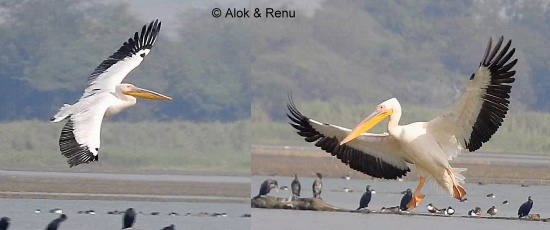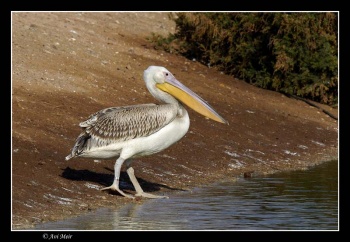- Pelecanus onocrotalus
Identification

Photo © by Alok Tewari
Nazafgarh Wetland and Marshes, Delhi-Haryana Border, India, January-2019
Length male 175 cm (68 in), female 148 cm (58¼ in), wingspan 225-360 cm, weight male 9-15 kg, female 5.5-9 kg
- Mostly white plumage.
- Long, loose nape feathers forming a short drooping crest.
- Wings with black primaries and secondaries, contrasting abruptly with white wing coverts, giving sharp pattern both above and below.
- Yellowish bare skin around eyes; flushes pink (male) or bright orange (female) in breeding display.
- Very large bill with yellow gular pouch.
- Orange legs.
Juvenile browner, with paler bill and no crest; immature mottled dark; gradually acquires adult plumage over 2-4 years.
Similar species
Dalmatian Pelican has a diffusely defined dark-to-pale wing pattern; juveniles and immatures less distinct, but Great White has more black on underwing than Dalmatian.
Distribution
Southeast Europe, central and southern Asia, and Africa. In Europe, breeding confined to Albania, Greece, Bulgaria, Romania, and Ukraine. Widespread in Africa, in Egypt, and a broad belt from Mauritania east to Sudan, and south through Kenya to Namibia and South Africa. In Asia, patchily distributed from Turkey east through northern India to Cambodia, and north to Kazakhstan. Northern populations in central Asia and southeast Europe migrate south to ice-free climates in winter.
Commonly kept in captivity; extralimital records, for example from northern Europe, usually (and in Britain, always) refer to escapes, rather than vagrant wild birds.
Taxonomy
This is a monotypic species[1].
Habitat
They are found in freshwater lakes,deltas, marshes and swamps.
Behaviour
Breeding
They normally ground nest in colonies, 2 eggs are normally laid.
Diet
Pelicans feed on fish by dipping their heads into the waer and scooping up the fish. They will sometimes gather in a group to round up the fish.
Vocalisation
References
- Clements, J. F., T. S. Schulenberg, M. J. Iliff, D. Roberson, T. A. Fredericks, B. L. Sullivan, and C. L. Wood. 2018. The eBird/Clements checklist of birds of the world: v2018. Downloaded from http://www.birds.cornell.edu/clementschecklist/download/
- Avibase
- Handbook of the Birds of the World Alive (retrieved August 2014)
Recommended Citation
- BirdForum Opus contributors. (2025) Great White Pelican. In: BirdForum, the forum for wild birds and birding. Retrieved 16 May 2025 from https://www.birdforum.net/opus/Great_White_Pelican
External Links
GSearch checked for 2020 platform.1






